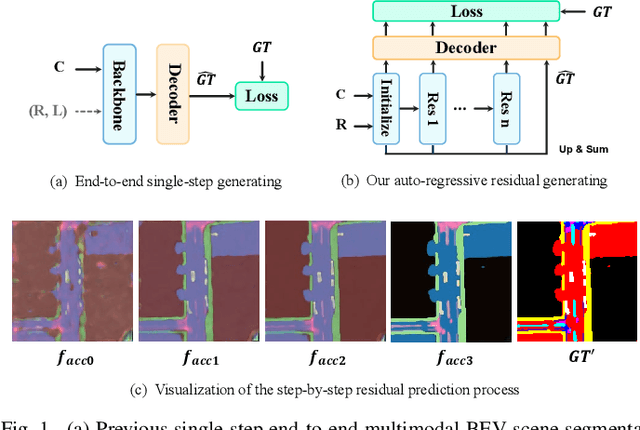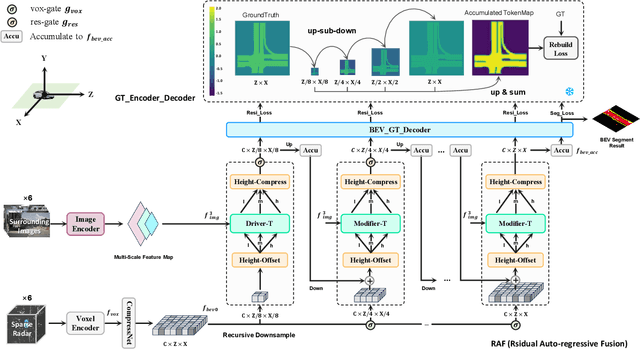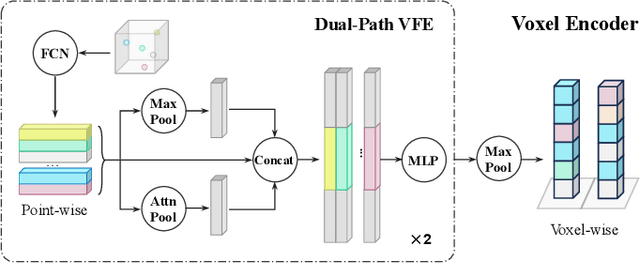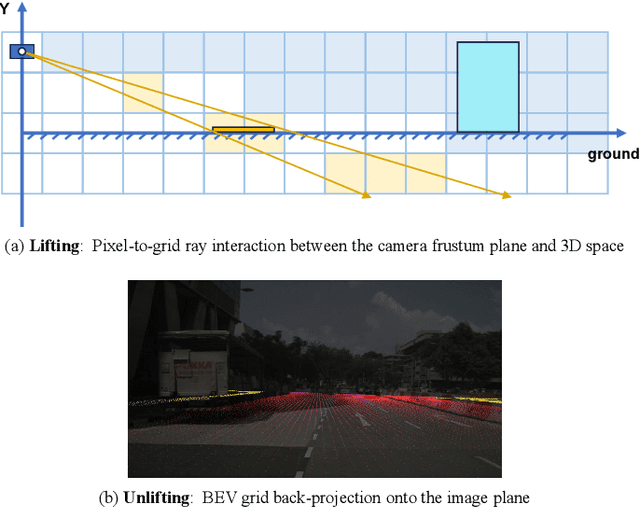Zheng Yuan
Istituto Italiano di Tecnologia, Italy, Università degli Studi di Ferrara, Italy
SegMo: Segment-aligned Text to 3D Human Motion Generation
Dec 24, 2025Abstract:Generating 3D human motions from textual descriptions is an important research problem with broad applications in video games, virtual reality, and augmented reality. Recent methods align the textual description with human motion at the sequence level, neglecting the internal semantic structure of modalities. However, both motion descriptions and motion sequences can be naturally decomposed into smaller and semantically coherent segments, which can serve as atomic alignment units to achieve finer-grained correspondence. Motivated by this, we propose SegMo, a novel Segment-aligned text-conditioned human Motion generation framework to achieve fine-grained text-motion alignment. Our framework consists of three modules: (1) Text Segment Extraction, which decomposes complex textual descriptions into temporally ordered phrases, each representing a simple atomic action; (2) Motion Segment Extraction, which partitions complete motion sequences into corresponding motion segments; and (3) Fine-grained Text-Motion Alignment, which aligns text and motion segments with contrastive learning. Extensive experiments demonstrate that SegMo improves the strong baseline on two widely used datasets, achieving an improved TOP 1 score of 0.553 on the HumanML3D test set. Moreover, thanks to the learned shared embedding space for text and motion segments, SegMo can also be applied to retrieval-style tasks such as motion grounding and motion-to-text retrieval.
Seed-Prover 1.5: Mastering Undergraduate-Level Theorem Proving via Learning from Experience
Dec 19, 2025Abstract:Large language models have recently made significant progress to generate rigorous mathematical proofs. In contrast, utilizing LLMs for theorem proving in formal languages (such as Lean) remains challenging and computationally expensive, particularly when addressing problems at the undergraduate level and beyond. In this work, we present \textbf{Seed-Prover 1.5}, a formal theorem-proving model trained via large-scale agentic reinforcement learning, alongside an efficient test-time scaling (TTS) workflow. Through extensive interactions with Lean and other tools, the model continuously accumulates experience during the RL process, substantially enhancing the capability and efficiency of formal theorem proving. Furthermore, leveraging recent advancements in natural language proving, our TTS workflow efficiently bridges the gap between natural and formal languages. Compared to state-of-the-art methods, Seed-Prover 1.5 achieves superior performance with a smaller compute budget. It solves \textbf{88\% of PutnamBench} (undergraduate-level), \textbf{80\% of Fate-H} (graduate-level), and \textbf{33\% of Fate-X} (PhD-level) problems. Notably, using our system, we solved \textbf{11 out of 12 problems} from Putnam 2025 within 9 hours. Our findings suggest that scaling learning from experience, driven by high-quality formal feedback, holds immense potential for the future of formal mathematical reasoning.
KidsArtBench: Multi-Dimensional Children's Art Evaluation with Attribute-Aware MLLMs
Dec 14, 2025Abstract:Multimodal Large Language Models (MLLMs) show remarkable progress across many visual-language tasks; however, their capacity to evaluate artistic expression remains limited. Aesthetic concepts are inherently abstract and open-ended, and multimodal artwork annotations are scarce. We introduce KidsArtBench, a new benchmark of over 1k children's artworks (ages 5-15) annotated by 12 expert educators across 9 rubric-aligned dimensions, together with expert comments for feedback. Unlike prior aesthetic datasets that provide single scalar scores on adult imagery, KidsArtBench targets children's artwork and pairs multi-dimensional annotations with comment supervision to enable both ordinal assessment and formative feedback. Building on this resource, we propose an attribute-specific multi-LoRA approach, where each attribute corresponds to a distinct evaluation dimension (e.g., Realism, Imagination) in the scoring rubric, with Regression-Aware Fine-Tuning (RAFT) to align predictions with ordinal scales. On Qwen2.5-VL-7B, our method increases correlation from 0.468 to 0.653, with the largest gains on perceptual dimensions and narrowed gaps on higher-order attributes. These results show that educator-aligned supervision and attribute-aware training yield pedagogically meaningful evaluations and establish a rigorous testbed for sustained progress in educational AI. We release data and code with ethics documentation.
Teacher Demonstrations in a BabyLM's Zone of Proximal Development for Contingent Multi-Turn Interaction
Oct 23, 2025Abstract:Multi-turn dialogues between a child and a caregiver are characterized by a property called contingency - that is, prompt, direct, and meaningful exchanges between interlocutors. We introduce ContingentChat, a teacher-student framework that benchmarks and improves multi-turn contingency in a BabyLM trained on 100M words. Using a novel alignment dataset for post-training, BabyLM generates responses that are more grammatical and cohesive. Experiments with adaptive teacher decoding strategies show limited additional gains. ContingentChat demonstrates the benefits of targeted post-training for dialogue quality and indicates that contingency remains a challenging goal for BabyLMs.
Probing Latent Knowledge Conflict for Faithful Retrieval-Augmented Generation
Oct 14, 2025Abstract:Retrieval-Augmented Generation (RAG) has emerged as a powerful paradigm to enhance the factuality of Large Language Models (LLMs). However, existing RAG systems often suffer from an unfaithfulness issue, where the model's response contradicts evidence from the retrieved context. Existing approaches to improving contextual faithfulness largely rely on external interventions, such as prompt engineering, decoding constraints, or reward-based fine-tuning. These works treat the LLM as a black box and overlook a crucial question: how does the LLM internally integrate retrieved evidence with its parametric memory, particularly under knowledge conflicts? To address this gap, we conduct a probing-based analysis of hidden-state representations in LLMs and observe three findings: knowledge integration occurs hierarchically, conflicts manifest as latent signals at the sentence level, and irrelevant context is often amplified when aligned with parametric knowledge. Building on these findings, we propose CLEAR (Conflict-Localized and Enhanced Attention for RAG), a framework that (i) decomposes context into fine-grained sentence-level knowledge, (ii) employs hidden-state probing to localize conflicting knowledge, and (iii) introduces conflict-aware fine-tuning to guide the model to accurately integrate retrieved evidence. Extensive experiments across three benchmarks demonstrate that CLEAR substantially improves both accuracy and contextual faithfulness, consistently outperforming strong baselines under diverse conflict conditions. The related resources are available at https://github.com/LinfengGao/CLEAR.
GenQuest: An LLM-based Text Adventure Game for Language Learners
Oct 06, 2025Abstract:GenQuest is a generative text adventure game that leverages Large Language Models (LLMs) to facilitate second language learning through immersive, interactive storytelling. The system engages English as a Foreign Language (EFL) learners in a collaborative "choose-your-own-adventure" style narrative, dynamically generated in response to learner choices. Game mechanics such as branching decision points and story milestones are incorporated to maintain narrative coherence while allowing learner-driven plot development. Key pedagogical features include content generation tailored to each learner's proficiency level, and a vocabulary assistant that provides in-context explanations of learner-queried text strings, ranging from words and phrases to sentences. Findings from a pilot study with university EFL students in China indicate promising vocabulary gains and positive user perceptions. Also discussed are suggestions from participants regarding the narrative length and quality, and the request for multi-modal content such as illustrations.
Beyond the Score: Uncertainty-Calibrated LLMs for Automated Essay Assessment
Sep 19, 2025


Abstract:Automated Essay Scoring (AES) systems now reach near human agreement on some public benchmarks, yet real-world adoption, especially in high-stakes examinations, remains limited. A principal obstacle is that most models output a single score without any accompanying measure of confidence or explanation. We address this gap with conformal prediction, a distribution-free wrapper that equips any classifier with set-valued outputs and formal coverage guarantees. Two open-source large language models (Llama-3 8B and Qwen-2.5 3B) are fine-tuned on three diverse corpora (ASAP, TOEFL11, Cambridge-FCE) and calibrated at a 90 percent risk level. Reliability is assessed with UAcc, an uncertainty-aware accuracy that rewards models for being both correct and concise. To our knowledge, this is the first work to combine conformal prediction and UAcc for essay scoring. The calibrated models consistently meet the coverage target while keeping prediction sets compact, indicating that open-source, mid-sized LLMs can already support teacher-in-the-loop AES; we discuss scaling and broader user studies as future work.
You Don't Need Pre-built Graphs for RAG: Retrieval Augmented Generation with Adaptive Reasoning Structures
Aug 08, 2025Abstract:Large language models (LLMs) often suffer from hallucination, generating factually incorrect statements when handling questions beyond their knowledge and perception. Retrieval-augmented generation (RAG) addresses this by retrieving query-relevant contexts from knowledge bases to support LLM reasoning. Recent advances leverage pre-constructed graphs to capture the relational connections among distributed documents, showing remarkable performance in complex tasks. However, existing Graph-based RAG (GraphRAG) methods rely on a costly process to transform the corpus into a graph, introducing overwhelming token cost and update latency. Moreover, real-world queries vary in type and complexity, requiring different logic structures for accurate reasoning. The pre-built graph may not align with these required structures, resulting in ineffective knowledge retrieval. To this end, we propose a \textbf{\underline{Logic}}-aware \textbf{\underline{R}}etrieval-\textbf{\underline{A}}ugmented \textbf{\underline{G}}eneration framework (\textbf{LogicRAG}) that dynamically extracts reasoning structures at inference time to guide adaptive retrieval without any pre-built graph. LogicRAG begins by decomposing the input query into a set of subproblems and constructing a directed acyclic graph (DAG) to model the logical dependencies among them. To support coherent multi-step reasoning, LogicRAG then linearizes the graph using topological sort, so that subproblems can be addressed in a logically consistent order. Besides, LogicRAG applies graph pruning to reduce redundant retrieval and uses context pruning to filter irrelevant context, significantly reducing the overall token cost. Extensive experiments demonstrate that LogicRAG achieves both superior performance and efficiency compared to state-of-the-art baselines.
Seed-Prover: Deep and Broad Reasoning for Automated Theorem Proving
Aug 01, 2025Abstract:LLMs have demonstrated strong mathematical reasoning abilities by leveraging reinforcement learning with long chain-of-thought, yet they continue to struggle with theorem proving due to the lack of clear supervision signals when solely using natural language. Dedicated domain-specific languages like Lean provide clear supervision via formal verification of proofs, enabling effective training through reinforcement learning. In this work, we propose \textbf{Seed-Prover}, a lemma-style whole-proof reasoning model. Seed-Prover can iteratively refine its proof based on Lean feedback, proved lemmas, and self-summarization. To solve IMO-level contest problems, we design three test-time inference strategies that enable both deep and broad reasoning. Seed-Prover proves $78.1\%$ of formalized past IMO problems, saturates MiniF2F, and achieves over 50\% on PutnamBench, outperforming the previous state-of-the-art by a large margin. To address the lack of geometry support in Lean, we introduce a geometry reasoning engine \textbf{Seed-Geometry}, which outperforms previous formal geometry engines. We use these two systems to participate in IMO 2025 and fully prove 5 out of 6 problems. This work represents a significant advancement in automated mathematical reasoning, demonstrating the effectiveness of formal verification with long chain-of-thought reasoning.
RESAR-BEV: An Explainable Progressive Residual Autoregressive Approach for Camera-Radar Fusion in BEV Segmentation
May 10, 2025



Abstract:Bird's-Eye-View (BEV) semantic segmentation provides comprehensive environmental perception for autonomous driving but suffers multi-modal misalignment and sensor noise. We propose RESAR-BEV, a progressive refinement framework that advances beyond single-step end-to-end approaches: (1) progressive refinement through residual autoregressive learning that decomposes BEV segmentation into interpretable coarse-to-fine stages via our Drive-Transformer and Modifier-Transformer residual prediction cascaded architecture, (2) robust BEV representation combining ground-proximity voxels with adaptive height offsets and dual-path voxel feature encoding (max+attention pooling) for efficient feature extraction, and (3) decoupled supervision with offline Ground Truth decomposition and online joint optimization to prevent overfitting while ensuring structural coherence. Experiments on nuScenes demonstrate RESAR-BEV achieves state-of-the-art performance with 54.0% mIoU across 7 essential driving-scene categories while maintaining real-time capability at 14.6 FPS. The framework exhibits robustness in challenging scenarios of long-range perception and adverse weather conditions.
 Add to Chrome
Add to Chrome Add to Firefox
Add to Firefox Add to Edge
Add to Edge